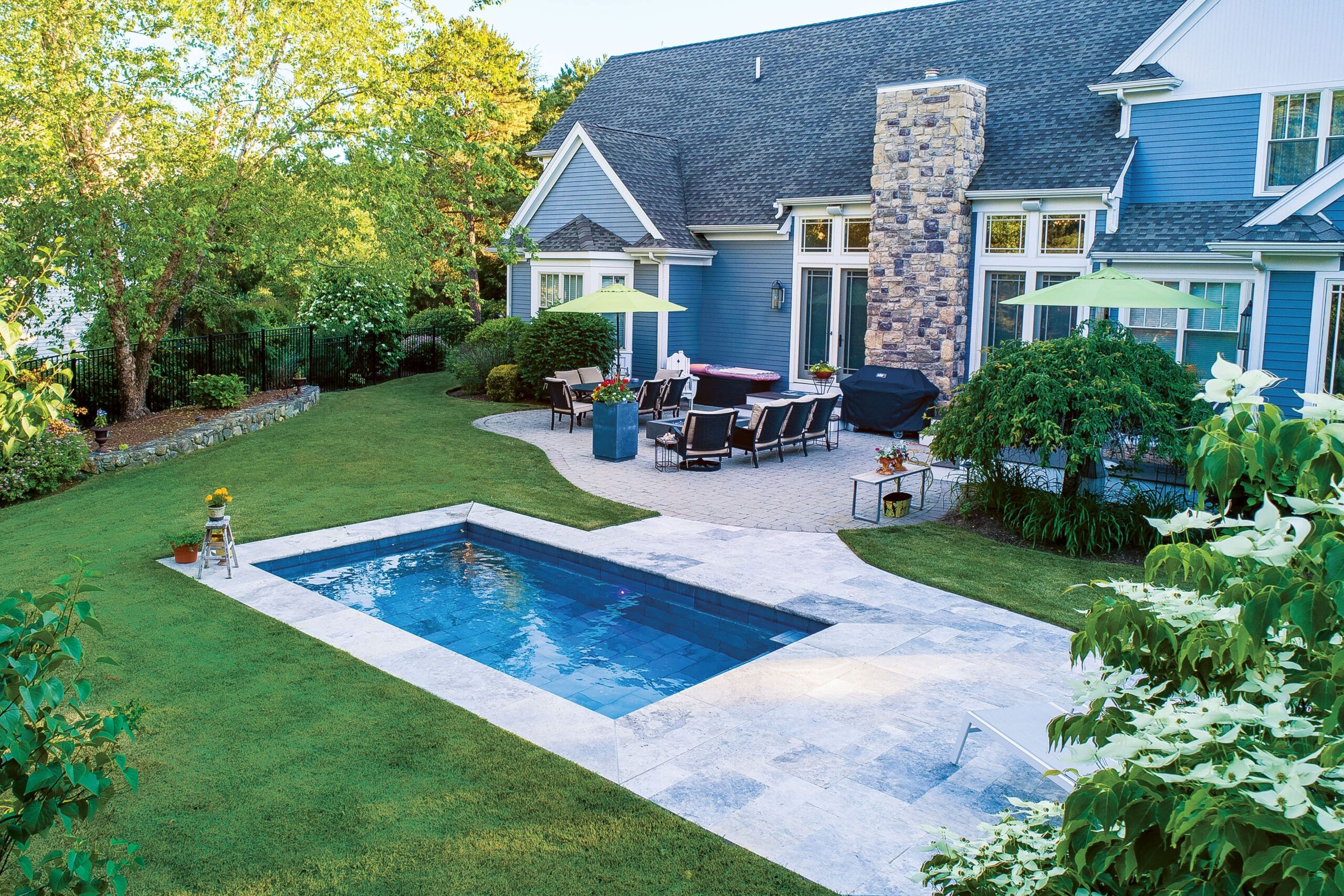Plunge pools are becoming increasingly popular for homeowners who want a refreshing oasis without the commitment of a full-sized swimming pool. Think of a plunge pool as the Goldilocks of backyard water features: bigger than a hot tub, easily heated, yet smaller and shallower than a traditional in-ground pool. They are perfect for cooling off on hot days, relaxing, and even therapeutic soaks. This buyer’s guide will cover everything you need to know about prefab plunge pools, helping you decide if one is right for you.
What is a Prefab Plunge Pool?
A plunge pool is designed for cooling off and relaxation, not for swimming laps. The ideal depth is around 4 to 5 1/2 feet, and sizes range from 7×7 feet to 20×12 feet. The rise in popularity started during the pandemic, as people sought ways to enhance their backyards. Landscape professionals, like TOH’s Jenn Nawada, have noted that homeowners prefer plunge pools for their lower maintenance and versatility. They can be heated or chilled and still leave room for other backyard features like patios, outdoor kitchens, or fire pits. Elevated plunge pools also serve as a sitting wall and can become a stunning focal point when lit at night.
Many owners like heated plunge pools, which offer year-round enjoyment. Doreen and John McLaughlin, for example, installed a heated 13×7 foot plunge pool in their backyard to enjoy even when the weather isn’t ideal for swimming.
One of the key advantages of plunge pools is their prefabrication. This allows you to prepare your yard while the pool is being manufactured off-site. Some prefab plunge pools can be ready for use just a day or two after delivery. Steel and concrete versions can be installed above ground, in-ground, or on slopes, making them versatile for various terrains.
Pros and Cons of a Prefab Plunge Pool
Before you invest in a plunge pool, consider the benefits and drawbacks:
Pros of Prefab Plunge Pools
- Ideal for Small Spaces: Plunge pools fit where traditional pools won’t. A 13’×7′ plunge pool is approximately half the size of a regular swimming pool, making it a great alternative if you don’t have the space for a traditional pool.
- Easier Maintenance: The smaller water volume is easier to balance and requires fewer chemicals, saving you time and money.
- Lower Year-Round Costs: Heating a plunge pool is significantly cheaper than heating a full-sized pool, making year-round use more affordable. You can also use a chiller for cold plunges, even in hot climates.
- Comfortable Height: Plunge pools usually have a flat bottom, providing a comfortable standing height for adults.
- Dual Functionality: Many plunge pools can be equipped with jets to function as a spa. Resistance currents can also be added for swimming or exercise.
- Slope-Friendly: Steel containers and concrete pools can be installed on slopes, reducing the need for expensive retaining walls.
Cons of Prefab Plunge Pools
- Potentially High Costs: While prefab plunge pools are cheaper to purchase, shipping and installation can significantly increase the total cost. Crane rentals, in particular, can be quite expensive.
- Not for Everyone: The shallow depth of plunge pools (48″ to 66″) is unsuitable for diving. If you have children who enjoy diving or waterslides, a plunge pool may not be the safest choice. They’re also not ideal for large groups playing water volleyball.
- Limited Design Options: Prefab plunge pools typically come in square or rectangular shapes. If you desire a more organic or custom shape, your options may be limited.
- Not Designed for Laps: Plunge pools offer limited space for swimming unless equipped with special resistance jets.
- Code Compliance Required: You still need permits and must adhere to local safety codes, regardless of the pool’s size.
Prefab Plunge Pool Vitals: Costs, Purchase, and Maintenance
Costs
- Precast concrete pools: Starting at $28,500 for a 7’×7′ pool (excluding shipping and installation).
- Container pools: Starting at $42,000 for a 20’×8′ pool (excluding shipping and installation).
- Molded fiberglass pools: Starting at $53,200 for a 9’6″×6’11” pool (including equipment and installation).
Where to Buy
Research online to find the best options. Contact manufacturers to see if they can connect you with local installers. Showrooms are rare, and fiberglass models are the most common to view in person.
Warranty
- Steel pools: Typically 1 year for structural warranties.
- Precast concrete: 2–5 years for structural warranties.
- Fiberglass: 25 years to lifetime for structural warranties.
Maintenance
Plunge pools require less maintenance than traditional pools. Regular upkeep involves maintaining pH balance with chemicals, skimming debris, and keeping chlorine and filter-media levels full. In cold climates, you’ll also need to winterize the system to prevent freezing.
TOH Pro Tip: Elevate your plunge pool 18 to 22 inches above grade, finishing the top edge with 18 to 24-inch-wide natural stone coping. This creates a comfortable seating area around the pool. —Jenn Nawada, Landscape Contractor
Types of Prefab Plunge Pools
Plunge pools come in various materials, each with unique attributes:
Concrete Plunge Pools
Precast concrete plunge pools are made using steel forms to mold a 4-inch-thick layer of masonry reinforced with steel rebar. The interior is waterproofed and covered with submerged-grade porcelain tile. Concrete pools can be installed above ground, semi-in-ground, or fully in-ground.
- Site Prep: Excavate the hole, lay a compacted gravel base, and dig trenches for pool equipment lines. Wiring is needed for the pump and lights, and a gas line for the heater. A crane might be required for placement, depending on site access.
- Sizes: Common sizes range from 7’×7′ to 20’×10′ with depths of 52″–66″.
- Prices: $28,500 for 7’×7′ to about $32,000 for 20’×10′ (with basic pool equipment).
Fiberglass Plunge Pools
Fiberglass pools offer a wider range of organic shapes. They are typically installed in-ground or semi-in-ground. Manufacturers offer details like steps, benches, and sun shelves molded into the pool. These are generally sold through a traditional pool company as part of an installation package.
- Site Prep: Similar to concrete pools, installation requires digging a pit and adding a compacted gravel bed. Electricians need to run wiring, and equipment is usually kept off to the side.
- Sizes: Common sizes range from 9’6″×6’11” to 20’×8′ with depths of 54”–60″.
- Prices: $53,200 for 9’6″×6’11” to $59,200 for 20’×8′ (installed, with pool equipment).
Steel Container Plunge Pools
Steel shipping containers are cut in half horizontally to create a pool. A closet usually houses the pool equipment. The exterior is wrapped in tough paint, and the interior has a multilayer coating or a fiberglass tub liner. Container pools can be installed above ground, semi-in-ground, or fully in-ground.
- Site Prep: These require footings and a crushed-gravel base or concrete pad for support. Wiring is needed for the pump, and a crane is often needed for placement.
- Sizes: Common sizes are 20’×8′ and 20’×12′, with a depth of 48″ or 57″.
- Prices: $42,000 for 20’×8′ to $56,000 for 20’×12′ (with a coated interior and basic pool equipment); $44,900 for 20’×8′ with a fiberglass liner (with pool equipment and heater).
Planning for a Prefab Plunge Pool Installation
A plunge pool project requires coordination with a landscape designer, contractor, or design-build firm. Once you agree on the pool’s location, the contractor will evaluate site access, handle permits, excavation, and crane rentals, as well as hire subcontractors. Remember that prefab pools are made to order, with a lead time of six to eight months.
During this time, the site can be prepped with concrete or a compacted gravel base, and utilities can be set up. Plumbing connections and filling the pool can add another day.
Crane Considerations
Factor in the cost of a crane to lift the pool into place, particularly on tight lots or for larger pools.
Local Codes
Check local codes to determine if a fence is required around the plunge pool. Also, ensure you adhere to property-line setbacks and secure permits for digging and adding electrical and gas lines.
Size Considerations
Plan for about 15 square feet of surface area per person. Aim for a depth that allows an adult to stand in chest- or shoulder-high water (48, 54, 60, and 65 inches are common).
DIY Kits
Consider a DIY kit with steel panels and a vinyl liner for a more affordable installation. Endless Pools offers kits that a capable DIYer can install above ground with minimal digging.
- Sizes: 6’×6′ to 16’×16′, and 42″ to 54″ deep.
- Cost: $12,999 for 7’×7′ (with pool equipment, heater, and a cover).
Installation Considerations for Plunge Pools
Permits and Yard Access
Ensure you have the necessary permits and clear yard access for machinery. Protect the path with plywood to avoid damaging the lawn or patio.
Mechanicals and WiFi Range
Designate a 4-foot-square space for pool equipment. Test the WiFi range from the planned location to ensure you can control the pool via smartphone.
Plunge Pool Design Features and Upgrades
Finishes
Fiberglass pools offer limited color choices, while concrete pools allow you to select from various liners or custom mosaics. Steel container pools can be custom colored to match paint chips.
Sun Shelves
A sun shelf offers a shallow area to sit or for pets to cool off. Fiberglass pools typically offer the most options.
Water Features
Adding a waterfall can transform a plunge pool into a backyard focal point.
Spa Jets
Upgrade your plunge pool with jets to create a therapeutic spa experience.
Resistance Currents
Install special jets that create a current you can swim or walk against, even in a small space.
Viewing Window
Steel container pools offer the option of a window cut into the side, allowing those outside to view the water action.
Site it Right: Plunge Pool Placement
Maximize sun exposure and keep the pool close to the house with a connecting pathway. Orient the pool to maximize the view from the built-in benches, preferably overlooking an open area.
Additional Comfort Features
- Lighting: LEDs can transform a plunge pool into a nighttime focal point.
- Heating and Cooling: Install a natural gas or propane-powered heater. In warmer climates, consider a pool chiller or heat pump.
Safety Features
Prevent Slipping
Use paver, brick, or stone with good slip resistance around the pool.
Fence it In
Comply with local codes regarding fencing. If required, install a gated fence at least 4 feet high around the pool.
Cover with Care
Use a cover to keep out debris, limit evaporation, and help retain heat. Consider an automatic cover for ease of use.
A prefab plunge pool is a fantastic way to enhance your backyard. By considering all aspects discussed in this buyer’s guide, you will be able to select the ideal plunge pool to create your own personal oasis.

